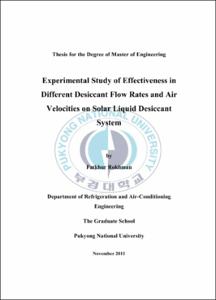Experimental Study of Effectiveness in Different Desiccant Flow Rates and Air Velocities on Solar Liquid Desiccant System
- Abstract
- Latest issue in the world is energy crisis and global warming, saving energy is one solution to solve energy crisis problem. In past decade air conditioning has been widely applied in human life especially in residential, office and industrial area such food, chemical, electronics, etc. In the industrial world the air humidity control have a huge role to produce a desirable high quality materials.
Humid air can cause mold and mildew to grow inside homes, which has various health risks. To be comfortable, people require a certain amount of ambient humidity. And the main reason why used air conditioning for long day in summer because of human comfort.
High water vapor content in air can cause a number of problems as for human or surrounding materials. In the industrial world the air humidity control have a huge role to produce a desirable high quality materials.
The effectiveness of solar liquid dehumidifier is an important point in Solar desiccant Air-conditioning. By knowing effectiveness in different flow rates of desiccant and different velocity of air input, the optimal setting for certain air properties input can be founded and can save electrical energy for pump and the chiller. The paper is investigate the temperature different between input and output, relative humidity, humidity ratio, moisture removal rate and effectiveness. This is helpful information to design the automatic system control for the Solar liquid desiccant air conditioning system.
- Issued Date
- 2012
- Awarded Date
- 2012. 2
- Type
- Dissertation
- Publisher
- Pukyong National University, Refrigeration and Air-Conditioning Engineering
- Alternative Author(s)
- Fatkhur Rokhman
- Affiliation
- master student pukyong national university
- Department
- 대학원 냉동공조공학과
- Advisor
- Kwang Hwan Choi
- Table Of Contents
- Abstract i
Contents iv
List of Figure vii
List of Table x
Chapter 1. 1
Introduction 1
1.1 Background of study 1
1.2 Human Comfort 1
1.2.1. Environmental Factors 2
1.2.2. Personal factors 4
1.3 Dehumidification 7
1.3.1. Mechanical Dehumidification 7
1.4 Objective of the Study 7
1.5 Advantage of the Research 8
Chapter 2. 10
Background Study 10
2.1 Humidity 10
2.1.1. Relative humidity 10
2.2 Dehumidification Methods 11
2.2.1 Cooling-based Dehumification 12
2.2.1.1 Direct Expansion Systems 12
2.2.1.2 Chilled Liquid Cooling System 14
2.2.1.3 Dehumidification-reheat 15
2.2.2 Desiccant Dehumidifiers 16
2.2.2.1 Solid packed tower 18
2.2.2.2 Rotating Honeycomb 19
2.2.2.3 Rotating horizontal bed 20
2.2.2.4 Liquid spray-tower 20
2.2.3 Sorbent 22
2.2.3.1 Solid adsorbent 23
2.2.3.2 Liquid desiccant 26
Chapter 3. 29
Experimental Setup 29
3.1 Experimental apparatus 29
3.1.1 Dehumidifier Systems 30
3.1.2 Regenerator Systems 33
3.2 Supporting Apparatus 36
3.3 Measuring Apparatus 39
3.3.1 Data Acquisition System 39
3.3.2 Sensors 39
3.4 Experimental Method 44
Chapter 4. 48
Experiment Result and Model Verification 48
4.1 Data Results 48
4.1.1 Dry Bulb Temperature 48
4.1.2 Relative humidity 49
4.2 Data Analysis 56
4.2.1 Mass Transfer Rate Analysis 56
4.2.2 Psychrometric 66
Chapter 5. 77
Conclusion 77
References 79
Acknowledgment 83
- Degree
- Master
- Files in This Item:
-
-
Download
 Experimental Study of Effectiveness in Different Desiccant Flow Rates and Air Velocities on Solar Li.pdf
기타 데이터 / 4.48 MB / Adobe PDF
Experimental Study of Effectiveness in Different Desiccant Flow Rates and Air Velocities on Solar Li.pdf
기타 데이터 / 4.48 MB / Adobe PDF
-
Items in Repository are protected by copyright, with all rights reserved, unless otherwise indicated.